Sir Charles Lyell, founder of modern geology
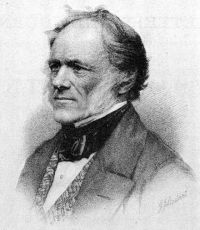
Sir Charles Lyell, author of Principles of Geology, first proclaimed the exceptional natural heritage value of the Joggins Fossil Cliffs: “...the finest example in the world of a natural exposure in a continuous section ten miles long, occurs in the sea cliffs bordering a branch of the Bay of Fundy in Nova Scotia.”
Geological accounts of the celebrated coastal section at Joggins first appear in the published literature in 1828–1829, by Americans C.T. Jackson and F. Alger, and by R. Brown and R. Smith, managers for the General Mining Association in the Sydney and Pictou coal fields. Brown and Smith’s account is the first to document the standing fossil trees.
Abraham Gesner

In 1842, Abraham Gesner, famous for the invention of the process of distilling kerosene from coal oil, accompanied Sir Charles Lyell on his first trip to Joggins. Lyell was drawn to the fossil forests of Joggins not out of singular interest in the trees, but for their implications for his theory on the terrestrial origin of coals, which is still very much the subject of current research.
Sir William Logan and the Geological Survey of Canada
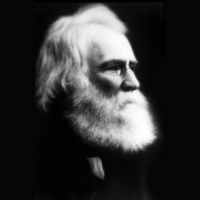
In 1843, Sir William Logan undertook the daunting bed-by-bed measurement of the entire Joggins coastal section, measuring a succession of sedimentary beds that totalled 14,570 feet, 11 inches. Logan’s impressive achievement served as the reference section for Joggins for 150 years. His work comprised the first field project of the Geological Survey of Canada.
Lyell, Dawson and Tree Stump Fauna
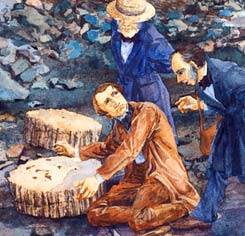
The early millipede Xyloiulus sigillariae was first found by Sir Charles Lyell and Sir William Dawson entombed in a fossil lycopsid tree (detail from Judih Pennanen's rendition of the discovery at Coal Mine Point from The Last Billion Years, Atlantic Geoscience Society).
In 1852, on his third trip to America, Lyell made his second excursion to the Joggins Fossil Cliffs, this time accompanied in the field by 32-year-old J. William Dawson, who would dedicate much of his remaining life to the study of the Joggins fossil record. At Joggins, Dawson and Lyell would make one of the most famous of fossil discoveries: tetrapods (including amphibians and later, by Dawson alone, reptiles) within the erect fossil trees, together with millipedes and the earliest land snails.
Lyell and Dawson’s discovery was first announced through the Lowell Lectures given by Lyell in 1852, in Boston, and in early 1853 was christened Dendrerpeton acadianum (“Tree reptile of Acadia”) in a paper read before the Geological Society of London, not by the discoverers, but — to Dawson’s chagrin — by the overly zealous Keeper of the British Museum.
O.C. Marsh, Dinosaur Hunter
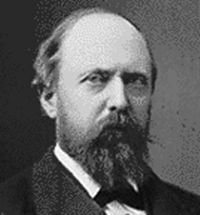
One of the first scientists to be drawn to Joggins by its growing fame was O. C. Marsh, the zealous “dinosaur hunter” of later years, who in 1855 was a wealthy young man of 24 just entering Yale University. Marsh’s report of two large vertebrae was proclaimed the remains of “Eosaurus acadianus.” Mystery surrounds the discovery to this day, as subsequent paleontologists now hold the vertebrae to be those of an ichthyosaur from Lyme Regis, Dorset, United Kingdom, home to the seaside fossil shop of Mary Anning. It remains a mystery whether Marsh was aware of the fact, or was duped into believing that they were from Joggins. In either case, the true origin of the vertebrae is a problem for Marsh!
The Big Picture: Lyell, Darwin and Dawson on Evolution
Lyell was delighted with his discovery with Dawson of “Coal Age reptiles” largely because it provided him with evidence in his long-standing campaign against the proponents of catastrophism, who argued that reptiles did not succeed fishes in the fossil record until the Mesozoic Era of dinosaurs. The true significance of these earliest reptiles at Joggins has only grown with the passage of time and development of evolutionary biology and paleontology.
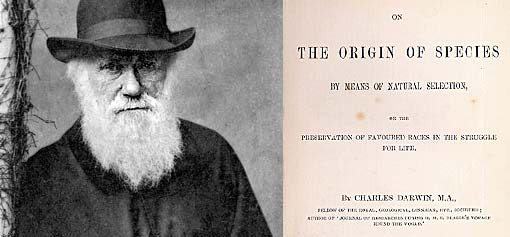
Did You Know?
Darwin was never knighted, unlike Lyell, Logan, and Dawson — or for that matter, Elton John and Mick Jagger!
With the publication of The Origin of Species in 1859, Charles Darwin drew on the completeness of exposure at Joggins and the ocurrence of the fossil forests to illustrate that the fossil record is inherently incomplete. What at first may seem a paradox was, in fact, a shrewd, pre-emptive argument against critics of gradual and progressive evolution. Darwin argued that even in the unrivalled exposures at Joggins, the intervening beds theoretically could hide “the fine intermediary gradations which must on my theory have existed between them,” with the result that the fossil record generally gives the misleading appearance of “abrupt, though perhaps very slight, changes of form.”
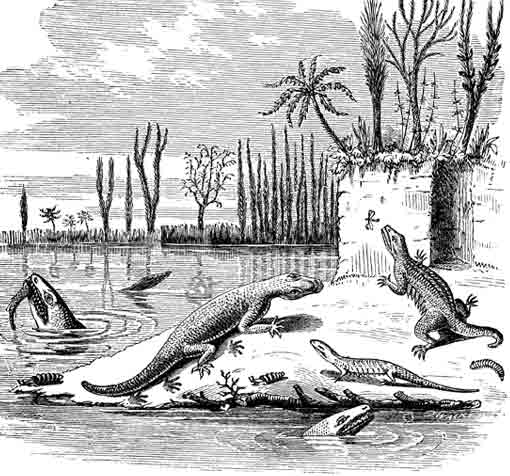
Dawson advocated that the discovery of essentially modern, conservative forms such as the land snail Dendropupa, virtually unchanged over millions of years, argued against Darwinian progressive change — imperfections in the geological record aside. Bishop Samuel Wilberforce, in his review and criticism of The Origin of Species had already taken obvious pleasure in chiding Darwin about “this miserable little Dendropupa.”
The contentious origin of coal
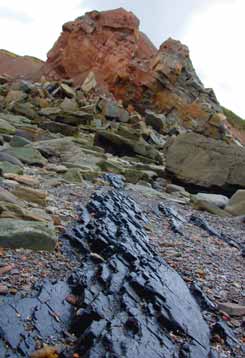
In the middle of the nineteenth century, as coal fuelled the Industrial Revolution, Charles Darwin wrote emphatically about the puzzling origin of coal, now known to have originated as peat beneath the vast tropical forest swamps, stating: “I shall never rest easy in Down church-yard, without the problem be solved by someone before I die.” Debate on the origin of coal revolved around the Joggins section. Coal beds remained enigmatic to scientists of the day, some of whom — including Darwin — speculated that they were of submarine origin. Logan, Lyell and Dawson all begged to differ based on field observations of standing tress rooted atop the coals.
For Darwin, it was the discovery of terrestrial fauna within the upright trees at Joggins that finally persuaded him of the terrestrial origin of coal and of the fossil trees. Thanks in part to Joggins, Darwin may now rest easy.
Dawson’s journey to the Coal Age World
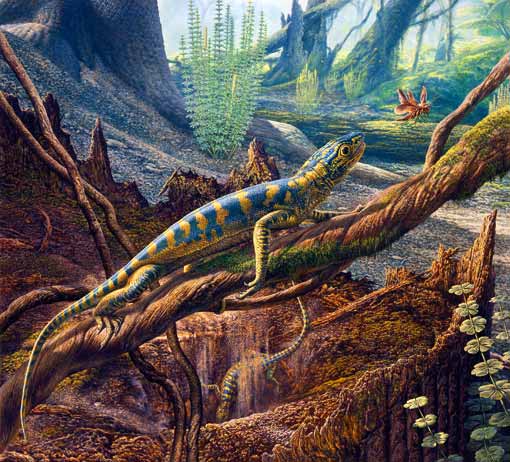
In 1859, Dawson reported to the Geological Society yet another discovery, Hylonomus lyelli, meaning “forest dweller”, named in honour of his mentor and friend, Sir Charles Lyell. It remains the earliest known amniote in the fossil record.
In 1877, armed with a grant of £50 from the Royal Society in London, and with the assistance — and explosives — of the mining company at Joggins, Dawson exposed an entire fossil forest horizon comprising 25 lycopsid trees. Incredibly, 15 entombed trees were productive, yielding more than 100 individual tetrapods, which remains the most significant single collection of Paleozoic terrestrial tetrapods in the world.
Joggins: new centuries dawn
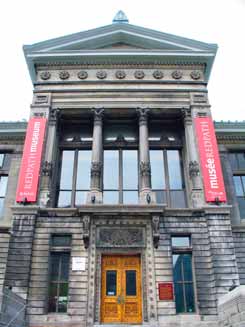
The Redpath Museum, McGill University, Montréal, built to house the collections of Sir William Dawson, today remains home to the most important collection of Dawson’s tetrapod fossils.
Research on the tetrapod record continued in the twentieth century. This research centred on restudies of Dawson’s collection, now largely housed at the Redpath Museum of McGill University, Montréal, but was supplemented by important new discoveries. A consequence of these studies led by Robert Carroll and his students and colleagues was an even greater significance for the tetrapod record at Joggins, the most significant element of which has been recognition of the earliest reptiles (and amniotes) in the fossil record of life.
Adding to the significance of the earliest amniote — ancestor of dinosaurs, birds, and lizards — is the presence of Protoclepsydrops, the earliest representative of the other main amniote lineage, the diapsids, which gave rise ultimately to mammals. The earliest fossil reptiles found by Lyell and Dawson 150 years earlier now figure prominently in emerging fields of evolutionary study, including the molecular clock.
![Joggins Fossil Institute [logo]](/assets/images/logos/joggins_fossil_cliffs_logo_white.svg)